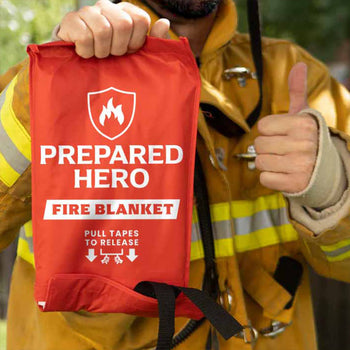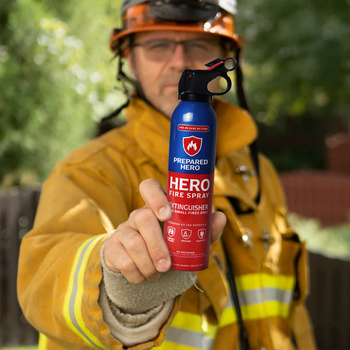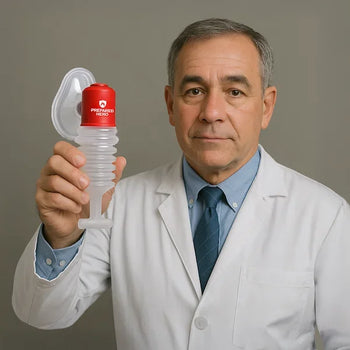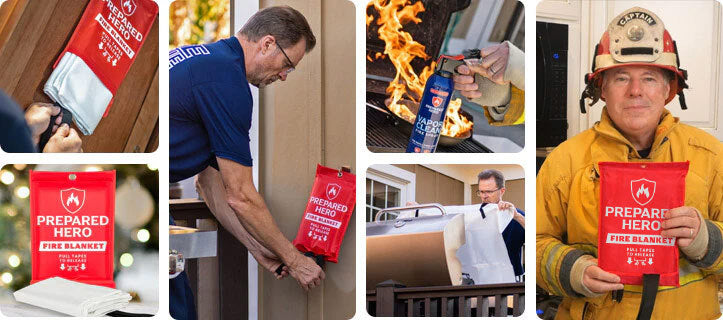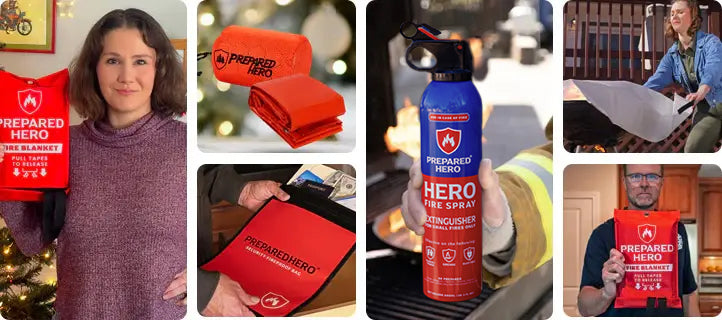Where you put your smoke detectors matters just as much as installing them. Proper placement makes sure they can detect...
Knowing who’s responsible for conducting hazard assessments keeps employees safe and healthy. But who exactly should do it? Are there any legal consequences if a hazard assessment isn’t done? Why is a hazard assessment important?
In this guide, we’ll go through what hazards are, what a hazard assessment is, why it’s important, and who’s responsible for it. We’ll also discuss how to do it according to the Occupational Safety and Health Administration (OSHA).
What Is a Hazard?

A workplace hazard is anything that could hurt someone or cause damage. If ignored, a hazard could lead to injuries or health issues. Spotting hazards is key to keeping everyone safe and healthy.
For example, a wet floor can be a slip hazard. If someone doesn’t see it and falls, that person might be injured. The same thing applies to heavy machines. If they’re not properly maintained, they could malfunction and cause serious harm to operators or nearby workers. Another common hazard is chemicals. If employees don’t have proper safety gear, they could face health issues because of direct contact or inhaling fumes.
Numbers show how hazards put people in danger, too. According to the OSHA, the death and accident or injury rates in shipyards are more than double those of other industries. This suggests that workers in shipyards are exposed to more hazards, and/or the hazards are not managed properly.
Types of Hazards

Hazards are everywhere and mostly unnoticeable. Knowing the types of hazards helps you spot them quickly. Learn more about the types of hazards in the workplace below:
Physical Hazards
According to the National Institute for Occupational Safety and Health (NIOSH), physical hazards are agents, factors, or circumstances that can cause damage through contact. These hazards can come from materials, tools, equipment, or the building’s layout.
Physical hazards are among the top causes of injuries in many industries. More risky industries, such as construction and shipyards, contain more physical hazards than less risky industries like retail and hospitality.
Here are some examples of physical hazards:
- Blocked exits: Clear pathways are crucial to employee safety, so make sure exits aren’t blocked.
- Clutter: Too much stuff lying around can cause people to trip and make going around hard.
- Faulty Wiring: Exposed wires or faulty equipment can lead to electric fires.
- Forklift traffic: Areas where forklifts operate can be life-threatening if not properly marked and controlled.
- Greasy floors: They’re common in kitchens and food prep areas and are the ultimate slip hazard.
- Hot surfaces: Tools or machines that get too hot can cause first or second-degree burns.
- Inadequate lighting: Poorly lit areas make it harder to see hazards and result in falls, slips, and trips.
- Loose tiles or carpets: Loose tiles and carpets can cause tripping injuries if they’re not fixed promptly.
- Moving machine parts: Machines in factories have moving parts that can cause injuries or death if not marked, used, or maintained properly.
- No handrails: Handrails help prevent falls, so they should be installed where needed.
- Noise levels: Excessive noise can distract employees and cause hearing problems over time.
- Open desk drawers: Open drawers can catch someone off guard and cause accidents.
- Overhead storage: Items stored above head height could fall and injure someone below.
- Poor ventilation: Poor ventilation causes discomfort and makes fires worse.
- Sloped walkways: Walkways without skid resistance can be life-threatening, especially in wet weather.
- Spills: Whether it’s a drink or a cleaning solution, spills should be cleaned up right away.
- Unstable ladders: Unstable ladders or scaffolding can cause injuries and death, especially from high places.
- Uneven walking surfaces: Bumps or cracks can cause employees to trip or fall.
Chemical Hazards
Chemical hazards are substances that can harm people because of their chemical properties. These substances can be in solid, liquid, or gas form. Exposure to chemical hazards can result in allergies, headaches, skin irritation, difficulty breathing, and more.
Chemical hazards in the workplace can come from many sources, such as cleaning products, solvents, and raw materials. Employees can ingest, inhale, or come into direct contact with chemicals.
According to the International Labor Organization, more than 1 billion workers are exposed to hazardous substances, including fumes and vapors. Many of these workers succumb to fatal diseases like cancer and poisoning or injuries from explosions and fires.
Here are some examples of chemical hazards:
- Solvents: Solvents like paint thinners can cause respiratory issues and skin irritation.
- Heavy Metals: Heavy metals like mercury (found in thermometers) and cadmium (found in batteries and some pigments) are toxic and can lead to many health problems.
- Aerosols: Aerosols like spray paints and air fresheners can cause respiratory problems and are often flammable.
- Cleaning products: Cleaning products like bleach can irritate the skin and eyes and produce toxic fumes when mixed with other chemicals.
- Paints: Many paints contain harmful chemicals that can make you dizzy when inhaled.
- Pesticides: They can be toxic to humans and pets if not used properly.
- Oils: Oils can be life-threatening if they overheat and catch fire.
- Gasoline: Gasoline is highly flammable and can cause respiratory issues if inhaled.
Biological Hazards
Biological hazards are substances from living organisms, including humans, animals, and plants that can harm people. These hazards are common in industries like healthcare, agriculture, and waste management.
Like chemical hazards, biological hazards can lead to many health problems, such as infections, respiratory issues, skin irritation, and, in severe cases, fatal diseases like cancer. Biological hazards can come from bodily fluids, waste, organic materials, and spores.
Here are some examples of biological hazards:
- Bodily fluids: Fluids like blood, saliva, and urine can contain infectious agents. Healthcare professionals and caregivers may encounter these fluids while caring for patients. For instance, exposure to blood can transmit HIV, hepatitis B, and hepatitis C.
- Fecal matter: Feces contain harmful bacteria and viruses, which can cause diseases like gastroenteritis. Exposure to fecal matter is often caused by sanitation work, agriculture, or improper hygiene practices.
- Mildew and molds: Fungi thrive in damp environments and can release spores that cause respiratory issues, allergies, and infections. Mildew and mold are commonly found in places with water damage or poor ventilation.
- Poisonous Plants: Some plants produce toxins that cause skin irritation, poisoning, or allergies. Common examples include poison ivy and wisteria.
- Contaminated Food: Contaminated food can result in foodborne illnesses, such as salmonella or listeria infections.
- Sewage: Wastewater contains pathogens, such as bacteria, viruses, and parasites. Sanitation and wastewater treatment workers are often exposed to this.
- Stinging Insects: Insects like bees, wasps, and hornets have painful stings, which can result in allergic reactions or anaphylaxis.
- Medical Waste: This includes used needles, contaminated scalpels, and biological samples. Improper handling can lead to infections and contaminate soil and water.
Ergonomic Hazards
Ergonomic hazards are factors, agents, or circumstances that can lead to musculoskeletal injuries. Ergonomics is all about designing workplaces to fit workers. It aims to make workstations, tools, and tasks safer, more efficient, and comfortable. However, ergonomic hazards get in the way of this.
When the body is stressed by awkward postures or repetitive movements, discomfort, fatigue, and pain occur. Musculoskeletal disorders (MSDs) are chronic injuries that affect your muscles, tendons, ligaments, and joints. These happen when your workplace or work practices aren't designed for safe and healthy movement. A common example of an MSD is carpal tunnel syndrome, where pressure on a wrist nerve results in pain and numbness in your hand.
Here are some examples of ergonomic hazards:
- Heavy lifting: Lifting heavy objects without proper technique strains the back and results in injuries. Employees should use the right lifting methods and, when possible, use tools or ask for help.
- Gripping: Tasks that require a tight grip for extended periods can strain the hands, wrists, and forearms, which can lead to MSDs.
- Improperly adjusted workstations: Chairs and workstations that aren’t fit for employees cause discomfort and back, neck, and shoulder pain.
- Improper footwear: Shoes without proper support or cushioning can result in foot and leg pain and poor posture, especially for workers who have to stand for many hours a day.
- Prolonged positions: Staying in one position for too long—whether sitting, standing, or kneeling—can overwork certain muscles and joints.
- Repetitive actions: Doing the same action repeatedly, like assembling products or typing, can lead to cumulative injuries.
- Lack of breaks: Not taking regular breaks increases strain and fatigue because muscles need time to recover from repetitive tasks.
What Is a Hazard Assessment?

A hazard assessment is a process that identifies potential hazards in the workplace before they can cause accidents or injuries. It’s a proactive step that helps create a safer work environment and comply with Occupational Safety and Health Administration (OSHA) guidelines.
The main focus of a hazard assessment is on the workers and the tasks they do. This includes analyzing the tools and equipment they use, as well as where they work. By closely examining these factors, employers can identify potential dangers that are not immediately obvious.
For example, you might find that certain machines are dangerous if safety guards are missing or if employees don’t know how to use them. In an office setting, you could see that hard chairs with poor lumbar support might lead to back pain.
Once hazards are identified, you should take steps to mitigate these risks. This could involve implementing safety protocols, providing proper training, or providing safety gear. The aim is to reduce accidents and make employees feel safe.
Overall, a hazard assessment is about being proactive rather than reactive. By identifying and managing hazards before they lead to incidents, employers promote a culture of safety. This protects employees and contributes to a more productive and efficient workplace.
Why Is a Hazard Assessment Important?

From prioritizing the safety of workers to better emergency preparedness, a hazard assessment is important for many reasons. Here are the reasons why you need to conduct a hazard assessment:
1. Keeps Everyone Safe
The primary goal of a hazard assessment is to keep everyone safe. For instance, you work in a warehouse. If someone spills something on the floor, the issue can be fixed right away—like cleaning it or putting up a warning sign. Doing this prevents workers from slipping and falling, which could lead to serious injuries.
2. Complies With Laws
The OSHA requires employers to evaluate the workplace to determine if hazards are present or likely to be present. For example, if a construction site skips these assessments and an accident occurs, they will face legal consequences. Think about a worker getting injured because of unstable scaffolding. Following regulations keeps companies out of legal trouble.
3. Boosts Morale and Productivity
When employees see their employers taking their safety seriously, their morale and productivity improve. Think about an office where ergonomic assessments are conducted. When workers know that the company makes sure their chairs and desks are comfortable, they feel more valued and engaged. Happy employees are more productive, which benefits everyone in the long run. When people feel safe, they can focus on their work instead of worrying about hazards.
4. Saves Money
While it seems like conducting hazard assessments is an extra expense, it can actually save money in the long run. For example, if a factory identifies potential hazards and provides safety gear, they could avoid a huge fire that might cost thousands in repairs and lost productivity. Similarly, compensation claims can be avoided if a restaurant identifies fire hazards and installs a kitchen fire suppression system. Remember, investing in safety measures now can lead to more savings later.
5. Creates a Culture of Safety
Hazard assessments also promote a culture of safety in the workplace. For instance, if a retail store encourages employees to report potential hazards, it shows that workers’ inputs are valued. An employee cleaning up a cluttered aisle prevents customers from tripping and falling. This shared responsibility creates a more proactive team. When safety becomes part of the daily routine, everyone wins.
6. Better Emergency Preparedness
Hazard assessments also prepare workers for emergencies. Let’s say a hospital conducts regular assessments related to patient handling. By doing this, they can provide the right equipment and train staff on proper patient procedures. If an emergency arises—like a patient who slips—the staff will be better prepared to help. Having clear protocols also ensures everyone knows their role and reduces panic.
Who Is Responsible for Conducting a Hazard Assessment?

According to the OSHA, employers are responsible for conducting hazard assessments. They are required by law to create safe work environments for their employees. This includes identifying hazards and taking steps to minimize or eliminate them. Key roles of employers include conducting hazard assessments, taking action, and training employees.
Employers are responsible for conducting hazard assessments, but they don’t have to do it themselves. For instance, a factory owner may assign an employee or hire a third party to do the hazard assessment. Whoever does the assessment is called the competent person.
According to the OSHA, a competent person can be a supervisor, crew leader, safety manager, or anyone on site with the highest level of safety training. The OSHA defines a competent person as someone who can identify existing and predictable hazards in the workplace. These hazards are unsanitary, hazardous, or dangerous to employees. The competent person is also authorized to take corrective measures to eliminate such hazards.
Once hazards are identified, the employer, competent person, and workers should take immediate action. This could involve providing personal protective equipment (PPE), personal protective equipment (PPE)training employees on ergonomics, and creating emergency kits with fire blankets, fire sprays, and first-aid kits. onomics, and having a maintenance schedule.
Employers also need to keep employees informed about potential hazards in the workplace. For instance, if a new machine is introduced to a factory, the company should train employees to use it safely.
The basis for hazard assessments isn’t just anecdotal. The OSH Act of 1970 upholds employers to safety standards, including reducing safety and health hazards. Without hazard assessments, they can’t do this.
While the heavy lifting of conducting hazard assessments falls on employers and competent persons, employees also play a huge role in making the workplace safe. For one, employees should report any hazards they encounter. If someone notices a leaking pipe, they should notify their supervisor immediately.
Employees are also required to attend safety training. For example, understanding the risks and hazards associated with fire is crucial for keeping everyone safe in a foundry. In addition, employees should follow safety protocols and use PPE when required. If a company provides fire protection gloves for welding, welders should wear them when doing their jobs.
At the end of the day, employers and employees should work together to keep the workplace safe. Employers are legally required to make sure hazard assessments are conducted and necessary actions are taken. On the other hand, employees should attend safety training sessions, use PPE when needed, and actively report potential hazards in the workplace.
How to Conduct a Hazard Assessment

Here’s how to conduct a hazard assessment, according to the OSHA:
1. Collect existing information about workplace hazards.
Workplace hazard information is out there for employers and workers. It can come from inside and outside sources. To collect information about workplace hazards, start by gathering, organizing, and reviewing what you have.
You can find useful information in several places, like:
- Operating manuals for equipment and machinery
- Safety Data Sheets (SDS) from chemical manufacturers
- Self-inspection reports from insurance companies or government agencies
- Records of past injuries and illnesses
- Workers' compensation records
- Patterns of common injuries and illnesses
- Results from exposure monitoring and industrial hygiene assessments (just make sure to keep personal information private)
- Existing safety programs, like lockout, tagout, and personal protective equipment guidelines
- Input from your team through surveys or safety committee meeting notes
- Job safety analysis
Don’t forget to check outside sources as well:
- OSHA, NIOSH, and CDC websites for their publications and alerts
- Trade associations and labor unions
- Local occupational safety committees or worker advocacy groups
- Safety consultants who can offer expert advice
2. Inspect the workplace for safety hazards.
Hazards in the workplace can pop up over time because of changes in processes, worn-out equipment, skipped maintenance, or cluttered work areas. Stay on top of things by doing regular inspections. Doing this lets you spot any issues before they lead to accidents.
Start by inspecting routine parts of your operations. Involve employees in the process. Letting them point out hazards they notice can provide valuable insights. Make sure to document everything so you can track what needs fixing. You should also take photos or videos to help encourage safety discussions later.
When you’re inspecting, don’t skip any areas. Check everything from storage spaces to maintenance routines and office functions, including the work done by contractors and temporary staff. Plus, don’t forget to inspect any vehicles used on-site, like forklifts and trucks.
3. Identify health hazards.
Health hazards are trickier to spot than physical ones. Many health hazards, like gases and vapors, are invisible and odorless, making them hard to detect without the right tools. Health hazards can also come from chemicals (like solvents and paints), physical factors (like noise and heat), biological agents (like infectious diseases), and ergonomic issues (like heavy lifting or repetitive tasks).
Start by identifying chemical hazards. Look at Safety Data Sheets (SDS) and product labels to find chemicals with low exposure limits or are highly volatile, especially those used in unventilated areas. Next, assess physical hazards, such as excessive noise, extreme temperatures, or radiation sources.
Don’t forget about biological hazards. Check if employees might be exposed to infectious diseases, mold, mildew, or waste that could cause allergies or asthma. Ergonomic risks are also important. Examine tasks that involve heavy lifting, working overhead, or repetitive motions.
You should also conduct quantitative exposure assessments using air sampling or direct-reading instruments whenever possible. Reviewing medical records can also help identify issues like musculoskeletal injuries or skin problems related to the workplace.
Remember that identifying and assessing these health hazards might require specialized knowledge. If you're running a small business, you can get free and confidential advice from OSHA's On-Site Consultation Program. They can help identify and assess workplace hazards.
4. Conduct incident investigations.
Workplace incidents, including injuries, illnesses, near misses, and the like, can give you a clear picture of where hazards are lurking. By digging into these incidents and reports, you can identify potential hazards. The goal of any investigation is to find the root causes, which often involve multiple factors, so you can prevent them from happening again.
Start by making a solid plan for conducting incident investigations. This plan should outline who’s involved, how communication will flow, what materials and supplies are needed, and reporting forms. Your investigative teams should also be trained to stay objective and open-minded.
When you conduct investigations, include a mix of management and worker representatives. Don’t overlook close calls or near misses; they can offer valuable insights, too. Focus on identifying and analyzing root causes to tackle any underlying issues that may have contributed to the incident.
Make sure to share the findings with managers, supervisors, and workers to help prevent similar situations in the future. Effective investigations go beyond just pinpointing one factor that caused an incident. Dig deeper by asking questions like “Why did this happen?” and “Why did this fail?”.
For instance, if a machine fails, ask if it was maintained properly. Was it too old? What could have been done to prevent it from failing? Similarly, if a worker makes a mistake, ask whether they have the right tools, proper training, and enough supervision. This thorough approach can improve workplace safety.
5. Identify hazards associated with emergency and non-routine situations.
Emergencies can create hazards that everyone needs to recognize and understand. Non-routine tasks, like equipment startups or shutdowns, have unique risks. It’s important to have plans and procedures to handle these situations safely.
Start by identifying possible emergency scenarios and non-routine tasks. Consider the materials and equipment used, as well as the layout of the building. Some scenarios to think about include:
- Fires
- Explosions
- Chemical spills
- Equipment shutdowns
- Infrequent maintenance tasks
- Structural collapse
- Disease outbreaks
- Weather emergencies
- Natural disasters
- Medical emergencies
- Workplace violence
6. Characterize the nature of identified hazards, identify interim control measures, and prioritize the hazards for control.
The last step is to evaluate the hazards you've identified and understand the potential incidents that could happen because of them. This information will help you create temporary controls and determine which hazards need permanent solutions first.
To do this, look at each hazard and think about how serious the outcomes could be, how likely it is for an incident to happen, and how many workers might be affected. Use temporary control measures to protect your team while you work on more permanent fixes. Prioritize hazards by focusing on the ones that pose the greatest risk first. Keep in mind that employers need to continuously manage all serious hazards to keep workers safe.
Remember, risk is a combination of hazard and exposure. You can lower risk by controlling or removing hazards or by reducing workers’ exposure to them. Evaluating risk helps you understand hazards and prioritize what needs to be addressed permanently.
Conclusion
Conducting a hazard assessment keeps the workplace safe and healthy. By spotting and checking out potential hazards—whether physical, chemical, biological, or ergonomic—employers can take smart steps to reduce risks for everyone.
This not only meets legal requirements but also makes employees feel valued and secure. Working together to focus on safety helps prevent accidents, boosts morale, and makes the workplace more productive. Taking the time to assess and tackle hazards pays off for everyone involved.
While a hazard assessment is originally designed for workplaces, you can follow the same steps to identify hazards at home. For instance, you can identify the hazards around your home and get the right tools to deal with them (like getting a fire blanket or fire spray for your kitchen).
Looking for reliable, easy-to-use, and affordable tools to help you deal with fire hazards? Check out Prepared Hero’s fire prevention tools here, and get up to 51% off on certain items. Stay safe, hero!


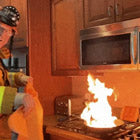 Fire
Fire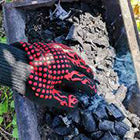 Safety
Safety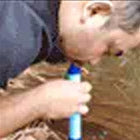 Survival
Survival Protection
Protection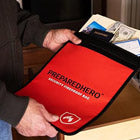 New
New
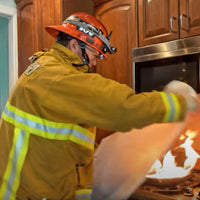 Fire
Fire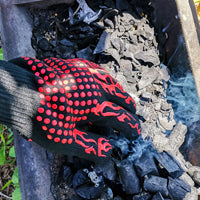 Safety
Safety Survival
Survival Protection
Protection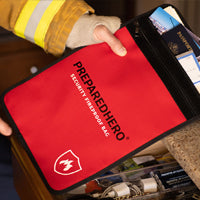 New
New
